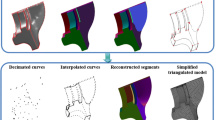Abstract
At present, there were two classical approaches commonly used for line simplification. One was Douglas-Peucker (D-P) algorithm and the other was Li-Openshaw (L-O) algorithm. Although the former was able to preferably reserve characteristic bending points of the curve and compress other non-feature points, the simplified result was excessively inflexible and sharp corners were also generated on feature points. As for the latter, not only can the corner of a line be smoothed, instead of becoming over inflexible, but feature point smoothing was also carried out by it for the line. Therefore, based on analyzing characteristics of such two algorithms, an improved algorithm was presented in this first place by means of combining the both together. To be specific, feature points of curves for generalized simplification were figured out by the D-P algorithm, while the L-O algorithm was used to perform curve processing by adjusting radius R of a circle SVO. In the end, real data were applied to carry out experimental verification contrasts for the modified algorithm and the existing two additional algorithms. Experimental results indicated that such a modified algorithm that combined them together exhibited their advantages and had the capability to reserve feature points and simplify other parts simultaneously. Moreover, it could be effectively applied in automated mapping.
Access this chapter
Tax calculation will be finalised at checkout
Purchases are for personal use only
Similar content being viewed by others
References
Douglas, D.H., Peucker, T.K.: Algorithms for the reduction of the number of points required to represent a digitized line or caricature. Can. Cartogr. 10(2), 112–122 (1973)
Li, Z.L., Openshaw, S.: Automatic synthesis algorithm for line elements based on objective laws of nature. Transl. Wuhan Univ. (1) 49–58 (1994)
Nako, B., Mitropoulos, V.: Local length ratio as a measure of critical point detection for line simplification. In: The Symposium of the 5th ICA Workshop on Progress in Automated Map Generalization, pp. 28–30 (2003)
White, E.: Assessment of line generalization algorithms using characteristics points. Am. Cartogr. 12(1), 17–27 (1985)
Liu, H., Fan, Z., Xu, Z., Deng, M.: Arc to chord algorithm modification and evaluation for curve simplification. Geogr. Geo-Inf. Sci. 27(1), 45–48 (2011)
Deng, M., Chen, J., Li, Z., et al.: An improved local measure method for the importance of vertices in curve simplification. Geogr. Geo-Inf. Sci. 25(1), 40–43 (2009)
Muller, J.C.: Fractal and automated line generalization. Cartogr. J. 24(1), 27–34 (1987)
Joao, E.M.: Causes and Consequences of Map Generalization. Taylor and Francis, London (1998)
Zhu, K., Wu, F., Wang, H., et al.: Li-Openshaw algorithm modification and evaluations. Acta Geodaet. Cartogr. Sin. 36(4), 450–456 (2007)
Wu, F., Zhu, K.: Evaluation on geometric accuracy of line element simplification algorithm. Geomat. Inf. Sci. Wuhan Univ. 33(6), 600–603 (2008)
Acknowledgment
Sponsor acknowledgments: Special Scientific Research Fund of Surveying and Mapping Geographic Information Public Welfare Profession (201512027); National SciTech Support Plan (2015BAJ06B01); Basic Scientific Research Business Expense Project of the Chinese Academy of Surveying & Mapping (7771606).
Author information
Authors and Affiliations
Corresponding author
Editor information
Editors and Affiliations
Rights and permissions
Copyright information
© 2017 Springer Nature Singapore Pte Ltd.
About this paper
Cite this paper
Li, C., Wu, P., Gu, T., Liu, X. (2017). A Study on Curve Simplification Method Combining Douglas-Peucker with Li-Openshaw. In: Yuan, H., Geng, J., Bian, F. (eds) Geo-Spatial Knowledge and Intelligence. GRMSE 2016. Communications in Computer and Information Science, vol 699. Springer, Singapore. https://doi.org/10.1007/978-981-10-3969-0_33
Download citation
DOI: https://doi.org/10.1007/978-981-10-3969-0_33
Published:
Publisher Name: Springer, Singapore
Print ISBN: 978-981-10-3968-3
Online ISBN: 978-981-10-3969-0
eBook Packages: Computer ScienceComputer Science (R0)




